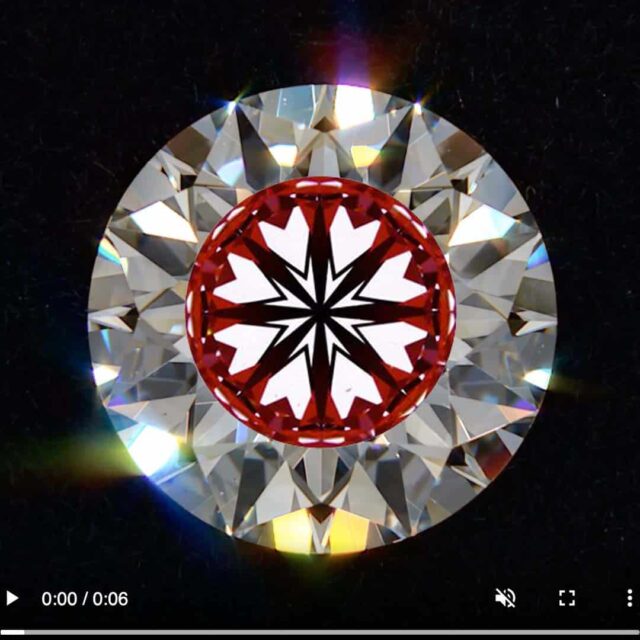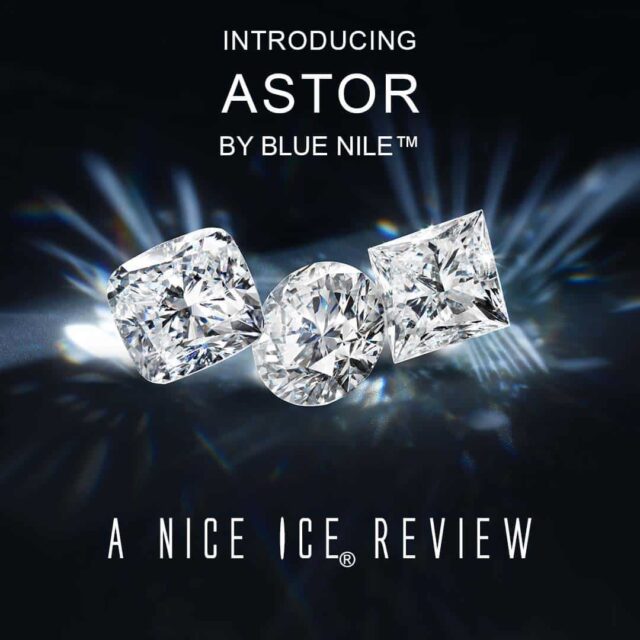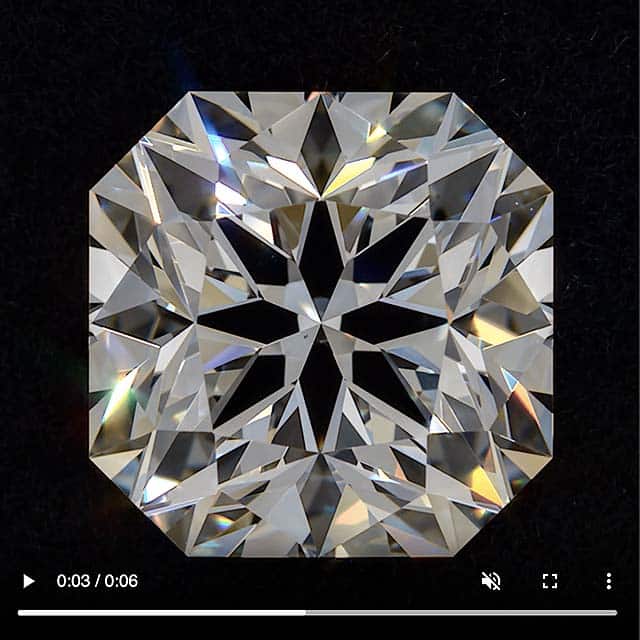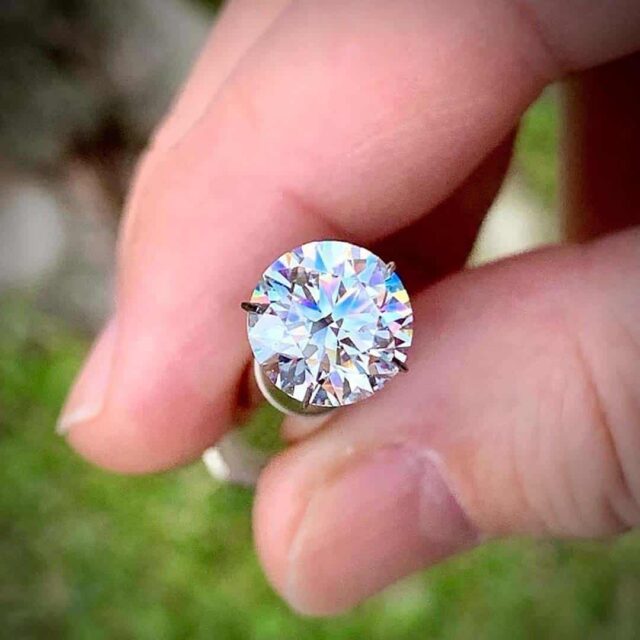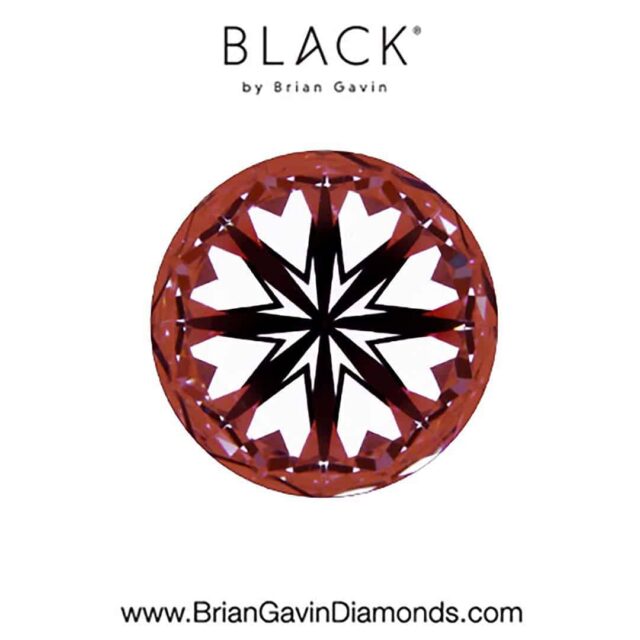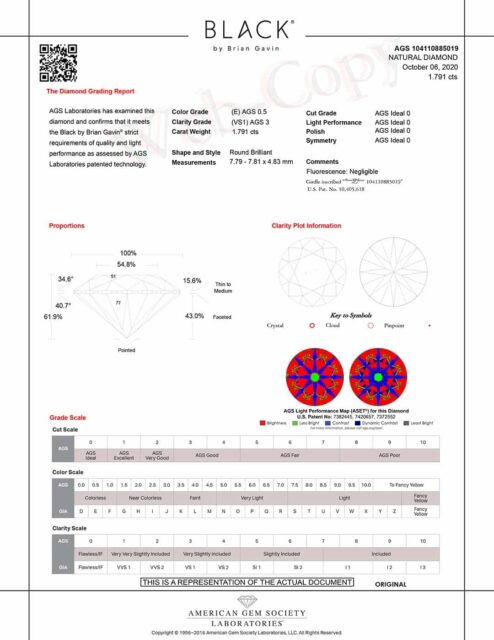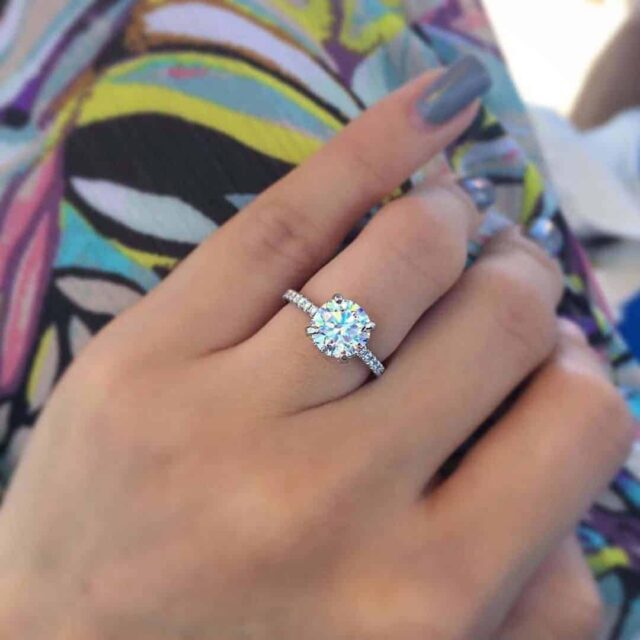The industry classifies Diamond Shapes into two categories, including round brilliant and fancy-shaped diamonds based on the geometric appearance or outline.
The various shapes of diamonds each have their Pros and Cons. For example, the modern round brilliant cut diamond reflects the light most evenly.
In contrast, the varying facet lengths of fancy shape diamonds reflect light in non-symmetrical patterns. As that may be, the sparkle factor of each shape demonstrates its unique personality.
Which Shapes of Diamond Are Most Sparkly?
First, it's a literary fact that diamonds sparkle and stars twinkle. According to Scrabble Finder, the word "Sparkliest" is worth 16 points in Scrabble.
It's also worth 18 points in Words With Friends. In that case, I'd say it makes the word "Sparkliest" real enough… My high school English teacher be damned! Consequently, there's an app for that called Grammarly.
In the diamond business, we use the term "Sparkle Factor" to describe Light Performance characteristics. In that case, we're combining the elements brilliance, dispersion, and scintillation into one group.
Conversely, it's easier to say "Sparkle Factor" than to type out the words brilliance, dispersion, and scintillation all day long. But, they each represent a specific characteristic of diamond sparkle that I will now clarify.
Brilliance is a Form of Bright Sparkle:
The term brilliance describes how bright our human eyes perceive the diamond to be. However, it is not only the amount of light return but also the perception of intensity.
Internal and external reflections of white light create this type of sparkle factor. Consequently, we judge the intensity of brilliance by viewing the diamond in the face-up position.
Dispersion is Flashes of Sparkly Colors:
The fiery flashes of sparkly colors that diamonds reflect are also known as dispersion. Those flashes of light are technically white, but our eyes disperse them into red, green, and blue sparkle.
Scintillation and Contrast Brilliance:
The varying degrees of contrast visible when you or the diamond is moving are known as scintillation. When light reflects off the facets, it creates contrasting patterns of sparkle in different intensities.
One of the benefits of hearts and arrows diamonds is that they exhibit more intense contrast brilliance. Consequently, the higher degree of optical precision creates more virtual facets within the diamond.
In that case, the sparkle factor is more vivid and intense. You will also see more significant light return and less light leakage. That will be evident through an ASET Scope, and the casual observer will see more sparkle.
The Dazzling Hue of Sparkling Wit Lingers in Diamondlandia:
That was quite a mouthful, as you can see. Perhaps now you can appreciate why we lump brilliance, dispersion, and scintillation together under the term sparkle factor.
Consequently, people tend to use the terms' light performance' and 'visual performance' interchangeably. Arguably, those terms appear to describe similar concepts, but there are technical differences.
The proportions of the diamond dictate the Light Performance. In other words, the pavilion angle will determine the volume of light return. Meanwhile, the crown angle and height will determine the balance of brilliance and dispersion.
In contrast, the consistency of facet shape, size, and alignment will directly impact visual performance. That is why we stand so high on our soapbox and rave about hearts and arrows diamonds.
The higher degree of optical precision that creates the H&A patterns also produces the most intense sparkle factor. Unfortunately, the gem labs do not take optical precision into account as part of the symmetry grade.
Which Diamond Shapes Are Brighter?
It seems like every brand claims that their diamonds are brighter,
most brilliant, and sparkle more than any other on the planet. However, that cannot possibly be true if they're all saying the same thing.
Conversely, our eyes' ability to interpret light reflecting off the facets also affects our appreciation of the sparkle factor. In that case, each person will interpret diamond sparkle differently.
Under those circumstances, a diamonds' sparkle factor is subjective and a matter of perception. As such, those marketing statements may be true to some degree but technically inaccurate in the strictest of terms. Ahem.
The Best Places to Buy Sparkly Diamonds:
How Facet Structure Affects Sparkle Factor:
First, the modern round brilliant cut diamond is the sparkliest due to the uniform facet structure. If you're looking for the best sparkle factor, I recommend Black by Brian Gavin.
Brian Gavin is a fifth-generation diamond cutter and holds the patent for maximizing light performance in the modern round brilliant. Refer to U.S. Patent #10,405,618 for additional details.
Consequently, they produce the most spectacular diamonds I've ever seen. The reason is simple. Team Gavin does not polish diamonds in the same manner as everybody else.
They also take the time to finetune the minor facets, creating more virtual facets and outward-bound sparkle. It's one of the reasons the Quadex from Brian Gavin also looks spectacular.
Are More Facets On A Diamond Better?
Contrary to the marketing efforts of specific diamond brands, more facets do not necessarily create more sparkle. Conversely, increasing the number of reflective surfaces might reduce the sparkle factor intensity.
I realize that statement appears to fly in the face of logic. However, it's a common misconception that more facets will make a diamond brighter.
Under those circumstances, the light splits into smaller pieces that are more difficult for our eyes to disperse into fiery sparkle. In that case, a modified round brilliant cut diamond might seem brighter because there is more brilliance (white sparkle).
But, in contrast, there will be less 'fire' since our eyes can't disperse the white flashes into colors. Fancy shape diamonds like this pear-shape from Brilliant Earth also have unique characteristics that many people find appealing.
Case In Point: Star 129 vs. Modern Round Brilliant:
This diagram shows the facet structure of a Star 129 modified round and a traditional 57-facet modern round brilliant. For the sake of argument, let's assume that the proportions of the diamonds are the same.
Specifically, the pavilion angle is 40.8 degrees offset by a 34.5 degree crown angle. The table diameter is 57%, and the girdle edge is medium, faceted.
In that case, the volume of light reflecting off the pavilion should be relatively equal. However, the sparkle factor of the two diamonds will be remarkably different.
The same principle applies to the other modified rounds like the Eighternity, Solasfera, and Leo Diamond. Each of which has its own set of pros and cons worthy of consideration.
The Sparkling Truth and Nothing But The Truth:
The Star 129 diamond features the same 33 facet design as the modern round brilliant. However, they split the 24 pavilion facets into 96 pieces. People tend to think that will make the diamond more brilliant.
However, we know from above that the term brilliance describes how bright our human eyes perceive a diamond. But, brightness is the amount of light return and the perception of intensity that reflections create.
In other words, it is the combination of internal and external flashes of white light visible in the face-up position. Arguably, a diamond seems brighter if there is more sparkle, but it's not without cost.
Will More Facets Make A Diamond Brighter?
The number of facets is not likely to affect the volume of light return because the diamonds have the same proportions. However, the number of reflective surfaces will influence our perception and intensity of the sparkle.
Therein resides the validity of marketing statements like the most brilliant-cut diamond, the brightest diamond, etcetera. Those blanket statements seem genuine because we see more sparkle.
As with most marketing slogans, they involve some misdirection and sleight of hand. It's like a game of three-card monte where the goal is to keep your eye on the Queen.
But, they forgot to say that equal parts brilliance, dispersion, and scintillation are necessary to win. In that case, the misdirection was getting you to focus only on brilliance instead of the complete package.
The Creation of Virtual Facets within a Diamond:

Virtual Facets Diagram Courtesty AGSL.
The illustration of 'virtual facets' shown here is courtesy of the American Gem Society Laboratory (AGSL). The creator is Jim Caudill, and it first appeared in the report on Sparkle Factor in February 2008.
This model shows the creation of virtual facets within a round brilliant cut diamond. Virtual facets occur when light splits apart into a kaleidoscope array of smaller shapes while the diamond is in motion.
As you can see, there are many virtual facets visible within the traditional 58-facet structure of this round diamond. As with a kaleidoscope, the virtual facet shapes blink in and out of existence with every movement.
Simultaneously, the reflective surfaces of those tiny mirrors reflect light and transform it into sparkle. Meanwhile, our eyes interpret the white light and disperse it into rainbow flashes of color.
Will More Facets Create More Virtual Facets?

The Kaleidescope Effect.
Increasing the number of reflective surfaces on a diamond will create more virtual facets internally. However, researchers at the AGS Laboratory concluded that those virtual facets would be smaller.
And therein lies the rip because human eyes can only interpret smaller flashes as white light. But, conversely, this is a matter of diminishing returns because more facets mean less fire.
That's why splitting more significant facets into smaller pieces is a bad idea. Although it might make a diamond more brilliant, it is at the expense of dispersion or fire. So much for the idea of having your cake and eating it too.
Accounting for Personal Taste (or lack thereof):
You'll notice that I'm not trying to convince you that a Black by Brian Gavin Diamond is better than a Star 129. On the contrary, I want you to be aware of the differences in light performance and decide for yourself.
Some people might like the smaller pinpoint type of brilliant sparkle that splitting facets apart creates. In contrast, I prefer more significant broad-spectrum flashes and a virtual balance of brilliance and dispersion.
One way to visualize the difference is to see how chandelier fobs with different facet patterns reflect light. In that case, more significant facets create bolder, brighter flashes of light.
In comparison, more minor elements will produce a disco ball effect similar to crushed ice. Suffice to say that broad-spectrum sparkle is a better choice because it shows up from across the room.
The Effect of Our Age Upon Perception of Brilliance in Diamonds:
If you're like most people, you might not like to think about the effects of aging. But, your eyesight will likely change as you get older. In that case, it's essential to understand the impact that will have on light performance.
Consequently, that is the premise behind Advanced ASET from the AGS Laboratory. The ASET-based Light Performance grading platform evaluates the diamond from two vantage points.
The idea is to see how the diamond appears from the 30 and 40-degree vantage points. Under those circumstances, the Advanced ASET Map on the Diamond Quality Document (DQD) shows varying degrees of contrast brilliance.
Conversely, the ASET-30 map on the left shows the type of contrast seen by younger eyes, while the ASET-40 map on the right provides a more mature perspective.
The Sparkling Sands of Time Sift Through the Hourglass:
Go ahead, say that sentence five times fast out loud. #NSFW.
Meanwhile, our ability to disperse white light into colors diminishes by the second. So, in that case, your diamond will likely look more brilliant and seem less fiery a few decades from now.
Under those circumstances, I think it's a good idea to forego the promise of extra brilliance now in favor of a more balanced look. You'll still get to enjoy a lot of fire throughout your life, but things may also look brighter.
No doubt there is a hidden message somewhere in that last sentence. I believe it was Lao Tzu that said, "Knowing others is wisdom; knowing yourself is Enlightenment."
Enlightenment Is A Characteristic of Brilliance:
That seems appropriate since we're talking about brilliance, dispersion, and scintillation, AKA Sparkle Factor. Consequently, this seems like an excellent opportunity to plant the seed in your mind for an upgrade.
I know what you're thinking. You're reading this rant on sparkle factor and light performance because you're shopping for an engagement ring. And this guy is already pushing the upgrade!
In my defense, I'm simply trying to do you a solid and help you see things from a realistic perspective. But, first, you need to accept the fact that your fiance will eventually experience Diamond Shrinkage Syndrome.
Second, the facets on three-carat diamonds are larger, so the sparkle will be more significant. Finally, given that our eyes have difficulty dispersing smaller flashes of light into fire, upgrading the diamond to maintain a sense of balance makes sense.
Keep in mind that we don't sell diamonds directly. Instead, we help people like you create spectacular-looking engagement rings. Please submit an inquiry via our Free Diamond Concierge Service.


